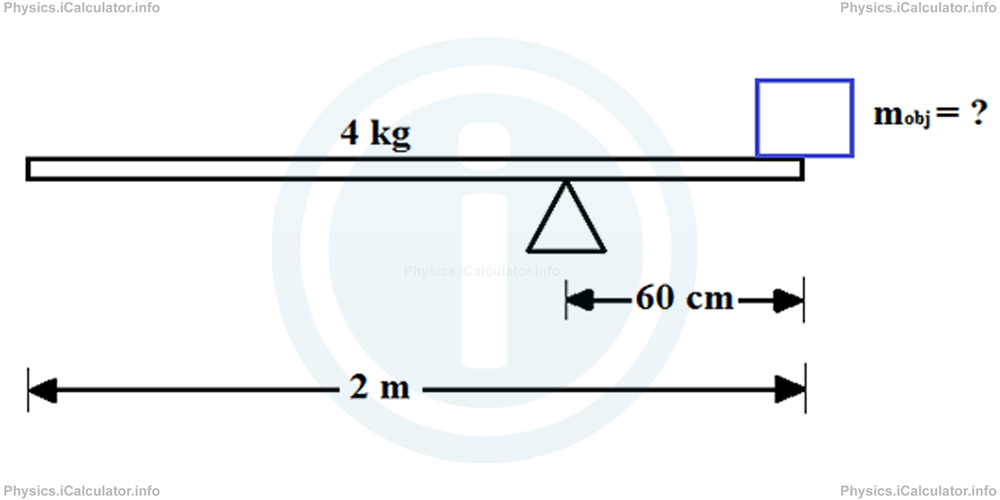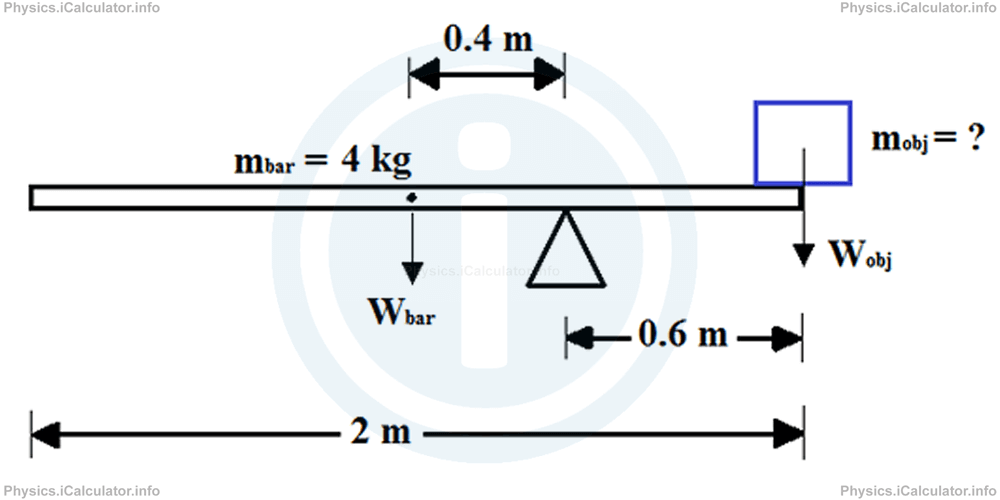Menu
Physics Lesson 6.4.5 - What if the bar is heavy and as such, we cannot neglect its weight?
Please provide a rating, it takes seconds and helps us to keep this resource free for all to use
Welcome to our Physics lesson on What if the bar is heavy and as such, we cannot neglect its weight?, this is the fifth lesson of our suite of physics lessons covering the topic of Moment of Force. Conditions of Equilibrium, you can find links to the other lessons within this tutorial and access additional physics learning resources below this lesson.
What if the bar is heavy and as such, we cannot neglect its weight?
In this case, we take the weight of the bar as an additional downward force exerted at the bar's centre of gravity. Then, we use the usual approach mentioned above. Look at the following example:
Example 5
A 4 kg uniform and homogenous bar is placed on a pivot as shown in the figure. 
What is the mass of the extra object we must place on the right end of the bar to set the equilibrium?
Solution 5
The bar exerts its weight at its centre because it is uniform and homogenous (as discussed in the tutorial "Centre of Mass. Types of Equilibrium"). Therefore, we must write a force equal at
= 4 kg × 9.81 N/kg
at middle of the bar, i.e. at
= 2m/2
= 1m
away from its left end. This means the centre of mass is 1 m - 0.6 m = 0.4 m on the right of the pivot, as shown below.

Therefore, we have dbar = 0.4 m and dobject = 60 cm = 0.6 m.
It is obvious that the bar's weight produces a anticlockwise moment while the extra object a clockwise moment because when there is equilibrium, the moments of force are equal and opposite.
Therefore, we have:
Simplifying g from both sides, we obtain for the mass of the extra object:
mobject = mbar × dbar/dobject
= 4 × 0.4/0.6
= 2.67 kg
You have reached the end of Physics lesson 6.4.5 What if the bar is heavy and as such, we cannot neglect its weight?. There are 7 lessons in this physics tutorial covering Moment of Force. Conditions of Equilibrium, you can access all the lessons from this tutorial below.
More Moment of Force. Conditions of Equilibrium Lessons and Learning Resources
Whats next?
Enjoy the "What if the bar is heavy and as such, we cannot neglect its weight?" physics lesson? People who liked the "Moment of Force. Conditions of Equilibrium lesson found the following resources useful:
- Heavy Feedback. Helps other - Leave a rating for this heavy (see below)
- Centre of Mass and Linear Momentum Physics tutorial: Moment of Force. Conditions of Equilibrium. Read the Moment of Force. Conditions of Equilibrium physics tutorial and build your physics knowledge of Centre of Mass and Linear Momentum
- Centre of Mass and Linear Momentum Revision Notes: Moment of Force. Conditions of Equilibrium. Print the notes so you can revise the key points covered in the physics tutorial for Moment of Force. Conditions of Equilibrium
- Centre of Mass and Linear Momentum Practice Questions: Moment of Force. Conditions of Equilibrium. Test and improve your knowledge of Moment of Force. Conditions of Equilibrium with example questins and answers
- Check your calculations for Centre of Mass and Linear Momentum questions with our excellent Centre of Mass and Linear Momentum calculators which contain full equations and calculations clearly displayed line by line. See the Centre of Mass and Linear Momentum Calculators by iCalculator™ below.
- Continuing learning centre of mass and linear momentum - read our next physics tutorial: Linear Momentum
Help others Learning Physics just like you
Please provide a rating, it takes seconds and helps us to keep this resource free for all to use
We hope you found this Physics lesson "Moment of Force. Conditions of Equilibrium" useful. If you did it would be great if you could spare the time to rate this physics lesson (simply click on the number of stars that match your assessment of this physics learning aide) and/or share on social media, this helps us identify popular tutorials and calculators and expand our free learning resources to support our users around the world have free access to expand their knowledge of physics and other disciplines.